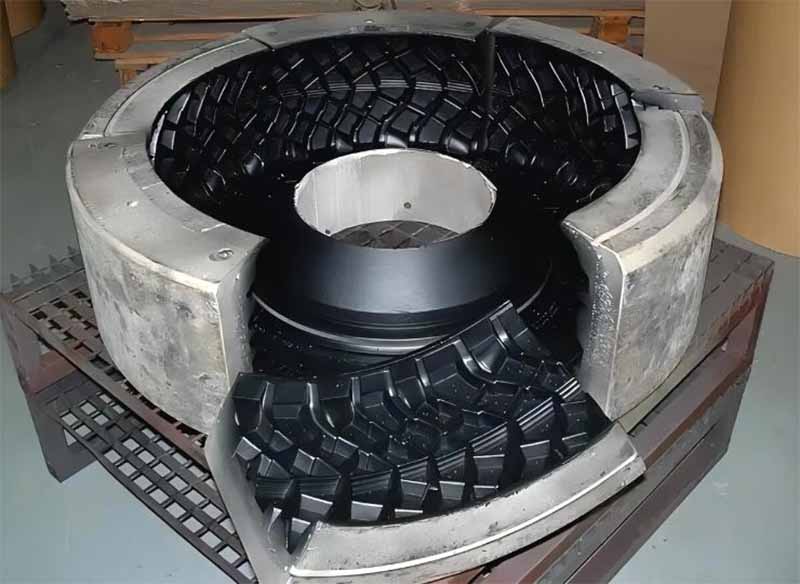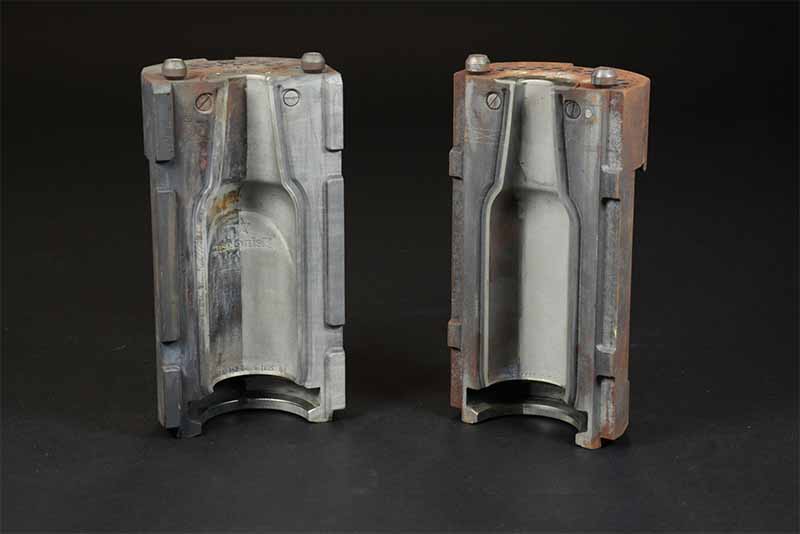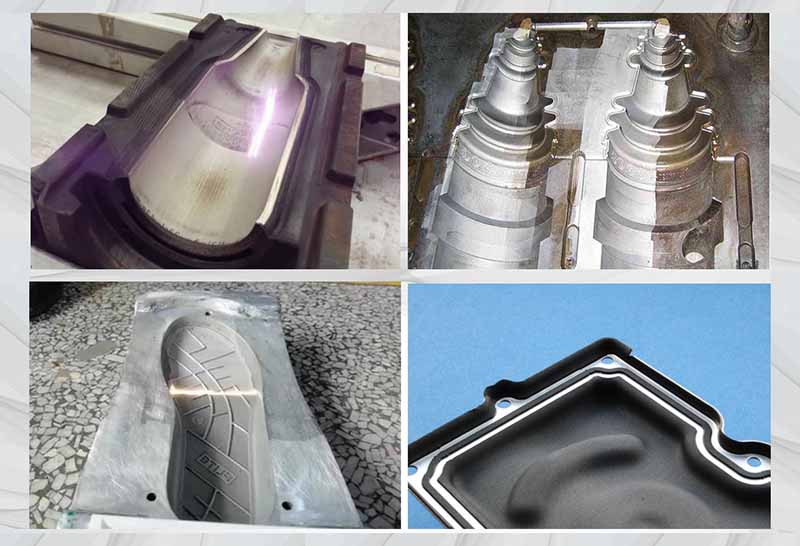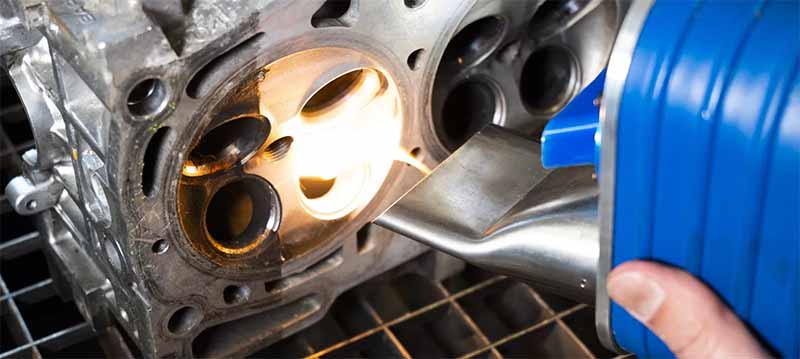Laser cleaning is transforming mold maintenance with its precision, efficiency, and non-abrasive approach, making it a superior alternative to traditional methods. This article delves into the benefits of laser mold cleaning, its common applications, and key factors to consider when selecting the best laser cleaning machine for mold.
How Does Laser Mold Cleaning Work?
Laser cleaning involves directing a high-energy laser beam onto the surface of a workpiece, causing the contaminants, oxide layers, coatings, or paint on the surface to instantly melt, ablate, evaporate, or peel off. This process cleans the surface of the workpiece without damaging the base material, making it an ideal choice for next-generation industrial cleaning technology.
Laser cleaning can remove rust, oil, and oxide layers, as well as adhesives, paint, dirt, coatings, and dust residues. This technology is also suitable for mold cleaning, primarily removing solid residues, rust, and oxide layers from the mold cavity surface. Laser cleaning machines have been widely used in injection mold laser cleaning and various mold cleaning, such as sealing ring molds, rubber molds, wheel hub molds, and stamping molds. Laser cleaning technology is increasingly being used in the mold industry because of its ability to efficiently remove contaminants from the surface of the mold while causing minimal damage to the mold itself.
Why Choose Laser Cleaning for Tire Mold?
Tire molds are essential tools for tire production; without molds, tires cannot be formed. Mold cleaning is a daily task in tire manufacturing plants and is a critical step in mold maintenance. It directly impacts the entire production process, as incomplete removal of residues can affect product quality. Laser cleaning can efficiently clean molds without damaging the mold’s base material.
Currently, tire mold cleaning methods include sandblasting, dry ice cleaning, chemical cleaning, and laser cleaning. Many tire factories are gradually replacing traditional cleaning methods with laser cleaning due to its advantages of being environmentally friendly, efficient, non-polluting, and non-damaging.

Laser Tire Mold Cleaning vs. Chemical & Mechanical cleaning
| Item | Laser Cleaning | Chemical cleaning | Mechanical cleaning |
| Cleaning method | Non-contact | Chemical cleaning agent | Mechanical/sandpaper |
| Damage | Non-abrasive | Contact type, gradual erosion | Contact type, damage |
| Cleaning efficiency | High | Low | Low |
| Consumables | Electricity | Chemical cleaning agent | Sandpaper, grinding wheel, oilstone, etc. |
| Cleaning effect | Very good, high cleanliness | General, uneven | General, uneven |
| Accuracy | Precise and reliable, high accuracy | Uncontrollable, poor precision | Uncontrollable, general accuracy |
| Safety and environmental protection | No contamination | Chemical pollution environment | Pollution |
| Operation | Simple operation, handheld or automated | Complex process flow, high requirements for operators, pollution treatment required | High physical strength, safety protection required |
| Cost | High initial investment, no consumables, low maintenance costs | Low initial investment, extremely high consumables cost | High initial investment, high labor cost and consumables |
Advantages: The Best Laser Cleaning Mold
Non-contact Cleaning:
Laser cleaning is a non-contact cleaning method, meaning it does not physically touch the mold surface, thus avoiding any physical damage to the mold.
High Efficiency and Energy Saving:
Laser cleaning offers a high cleaning speed, allowing tasks to be completed in a short time. Compared to traditional cleaning methods, laser cleaning often saves both energy and time costs.
Precise Control:
Laser cleaning allows for precise control of cleaning parameters such as energy, density, and focus. This makes it suitable for detailed cleaning of mold surfaces without affecting the mold’s shape, size, or fine surface structures and details, such as letters and bolts. This precision makes laser cleaning particularly suitable for situations where high surface quality is required.
High Degree of Automation:
Laser cleaning machines can be integrated with automated production lines, enabling an automated cleaning process that improves production efficiency and consistency.
High-Precision Cleaning:
Laser cleaning allows precise control over the cleaning area and depth, ensuring thorough cleaning while maximizing the protection of the mold surface’s accuracy and quality.
Low Operating Costs and Excellent Cleaning Effect:
Compared to other technologies, low energy consumption, no consumables, and minimal waste disposal costs ensure unmatched low overall operating costs.

Application of Laser Cleaning in Molds
Injection Mold Laser Cleaning
Injection mold laser cleaning is an efficient and precise technique designed to remove contaminants such as residual plastics, oils, oxides and other impurities from the surface of injection molds. This method significantly reduces mold maintenance time and increases productivity. It is particularly effective in cleaning complex shapes and small recesses, areas that are difficult to reach with traditional methods. Laser cleaning not only improves mold cleanliness but also extends mold life, making it an indispensable and efficient cleaning solution for the injection molding industry.
Food Mold Cleaning
In the food industry, moulds require frequent cleaning to ensure safety and hygiene. Traditional methods may involve chemical solvents or mechanical scrubbing, which can leave chemical residues or damage the mold surface. Laser cleaning systems remove contaminants such as grease and carbide without the use of chemicals, ensuring clean and safe food contact surfaces.
Rubber Mold Cleaning
Rubber molds are commonly used to produce a variety of rubber products such as seals and tires. These molds can be contaminated with vulcanization residues, release agents and other organic substances. Laser cleaning effectively removes these contaminants without damaging the fine surface structure of the mold, helping to extend mold life and improve product quality consistency.
Plastic Mold Cleaning
Plastic molds are used in a wide range of industries including automotive, electronics and medical manufacturing. Keeping plastic molds clean is critical to ensuring product surface quality and dimensional accuracy. Laser cleaning machine accurately removes resin residues, release agents and oxidation from mold surfaces, reducing maintenance time and costs.
Glass Mold Cleaning
Glass molds are primarily used to produce glass bottles and glassware. Over time, these molds accumulate dust, grease and glass fragments. Laser cleaning effectively removes these contaminants and maintains the smoothness and flatness of the molds, thus ensuring a quality appearance of the final product.
Composite Mold Cleaning
Composite molds are commonly used in industries such as aerospace, automotive, and sports equipment to produce high-performance parts such as carbon fiber reinforced plastic (CFRP). The cleanliness of these molds directly affects the quality of the composite bond. Laser cleaning removes resin residues and release agents while preserving the mold’s micro-texture, improving the quality of composite parts.

How to Choose the Laser Cleaner for Mold?
Removing rust, paint, oil and oxidized layer on metal surface is the most applied field of laser cleaning. Between the different lasers in the wavelength, power and other important parameters of the difference, different materials, pollutants on the laser parameters are different, in the actual cleaning work need to be set according to the actual situation of laser cleaning parameters.
Laser cleaning machine has two types: continuous wave laser cleaning machine and pulsed laser cleaning machine. Due to the use of different types of lasers, these two types of equipment in the performance and application scenarios have their own characteristics, the user can choose according to the specific cleaning needs.
CW Fiber Laser Cleaning Machines
Power range typically from 1000W~3000W.
With a continuous output laser beam, these machines are well-suited for large-scale cleaning tasks, particularly excelling in removing extensive rust, oxide layers, and heavy contaminants.
Pulsed Fiber Laser Cleaning Machines
Power range generally from 100W~450W.
Pulsed laser cleaning machines emit high-energy laser pulses in short bursts, allowing for the precise removal of surface contaminants without damaging the underlying material. This makes them ideal for cleaning precision molds, removing paint coatings, and handling high-precision equipment components. Although these machines are typically more expensive, their exceptional precision and detailed cleaning capabilities make them highly valued in high-end manufacturing and precision instrument maintenance.
The Best Laser Mold Cleaner
Are you looking for a cheap laser cleaning machine for tire molds, rubber molds, shoe molds, injection molds, and glass molds? Our handheld laser cleaning machine offers unique advantages by allowing cleaning moulds while they remain in place and operational, significantly reducing downtime. It is compatible with various materials and adaptable to complex industrial manufacturing scenarios, featuring high precision and efficiency. The operation is simple and highly automated.

Features:
Handheld Design: The lightweight handheld design allows the operator to easily reach hard-to-reach locations for improved cleaning efficiency.
Simple and easy to use: The operator interface is intuitive and can be used proficiently after a short training.
High degree of automation: The automation control function, which can preset cleaning parameters and realize one-button start, simplifies the operation process and improves work efficiency.
High precision: Setting each laser parameter through the visualization window accurately removes pollutants without damaging the surface of the mold.
Easy to maintain: laser cleaners usually have a simple structure and low maintenance costs.
As a manufacturer with years of experience and technical expertise in mold laser cleaning machines, DP Laser not only provides high-quality equipment but also professional after-sales service and technical support to ensure customer satisfaction and trust. Our mold laser cleaning machines are known for their stable performance and low maintenance costs, providing customers with a better return on investment.
In conclusion, choosing the best laser cleaning machine for molds significantly boosts maintenance and production efficiency. Laser technology offers precision and sustainability, enhancing product quality and turnaround times. Whether for plastic injection or metal stamping molds, investing in a reliable mold laser cleaning machine is key. Ensure it offers versatility, durability, and cutting-edge technology to meet modern manufacturing demands while maintaining high standards of cleanliness and performance. The maintenance of molds is especially important for your industrial manufacturing, if you have anything want to know about laser mold cleaning, please feel free to leave a comment at the bottom of the article.




